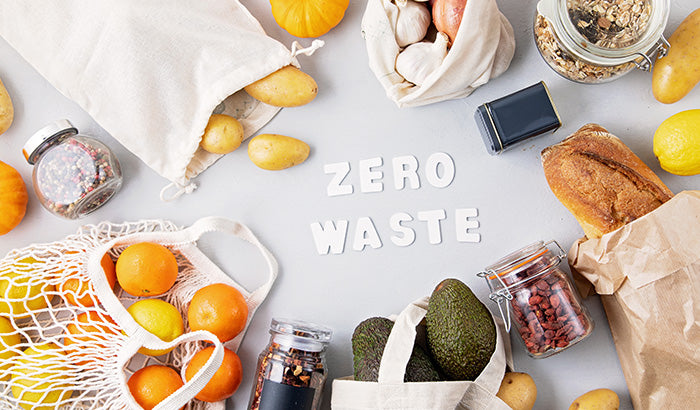What's New at Wazoodle
What's New

Reusable food bags have taken food storage systems by storm as an eco-friendly alternative. And it’s a good thing, too, since approximately 60% of all plastic produced worldwide is used for storing or packaging food!
Sixty percent? Yes, we know it’s a lot! And you can think of it in numbers, too. Of 380 million metric tons of plastic, 228 million were used for food packaging in recent years.
With overflowing landfills and concerns about the environment's health, many consumers and manufacturers are switching to eco-friendly options that reduce what goes into landfills. Our landfills are a necessity, but being overrun with plastics is causing a whole other set of problems.
Another rising concern is how non-degradable plastic packaging affects human health. Plastic packaging is often treated with toxic chemicals and harmful finishes that store food well but seep into our systems and cause health issues.
Today’s blog is all about reusable food bags – why you should use them and what types of reusable food bags you should purchase.
Without further ado, here are three reasons it’s worth it to have reusable food bags.
Landfills are used to properly dispose of solid waste that won’t break down on its own. They are necessary as they prevent environmental destruction and disease and help our homes and communities to stay clean.
But landfills aren’t a perfect solution. They prevent a lot of environmental waste, but they also cause some. So, while we need landfills, we also need to exercise caution with how much goes into our landfills.
Overflowing landfills are a massive problem in the U.S. because they release methane gas, carbon dioxide, water vapor, and trace amounts of oxygen, nitrogen, hydrogen, and non-methane organic compounds. These gases aren’t good for the environment. They create heavy smog and contribute to climate change.
Landfills take up a lot of space – hundreds of acres, to be exact. Those acres of land are usually taken away from the wildlife creatures that would naturally inhabit them. They’re left to find a new place to make their home.
Wildlife cannot safely make a home anywhere near a landfill due to the risk of ammonia and the resulting “dead zones.” Landfills come with plastic or clay lining to prevent the leachate that produces ammonia, but those liners often crack or break. In a landfill that covers hundreds of acres, that can be pretty hard to spot.
Another reason to avoid plastic bags is because of the toxic chemicals that are in them. Granted, manufacturers don’t have “toxic chemicals” on their list of things to put in plastic bags. But they do use phthalates, PVC, BPA, and BPS, all of which are chemicals that make the plastic less brittle.
Unfortunately, these chemicals also disrupt hormones and are linked to cancer, early puberty, and infertility. BPA was banned in baby products, but it’s still present in some other plastics that aren’t meant for young children.
The only way to entirely avoid these chemicals is by avoiding plastic products.
A box of Ziploc bags isn’t that expensive, but the cost adds up. A three-pack of washable, reusable food storage bags costs about the same as a box of Ziploc bags. You won’t save money instantly, but you will as time goes on. Wash and reuse your food storage bags 150 or so times, and you’ll start saving money.
If you’re considering switching to reusable food bags, we’d like to offer some suggestions to help narrow your search. Here’s a list of our top recommendations
Glass containers are reusable, recyclable, and durable. They’re easy to pack and clean out, and you can eat right out of them. Glass lids are known to leak, so be super careful if you need to transport leftovers. And make sure the cover that goes with your glass container doesn’t contain BPA!
If you opt for stainless steel, make sure it’s food-grade that won’t rust. We don’t want you getting sick! Stainless steel is excellent for bringing your lunch to work or storing dry foods in your pantry.
Bamboo is biodegradable, durable, and heat resistant. It’s the kind of all-in-one food packaging you’re looking for. Many types of food storage containers are made entirely or partially of bamboo.
You can purchase lunch boxes and serving bowls made of rice husk, a byproduct of rice farming. You’ll want to exercise caution if you use reusable containers or food bags made of rice husks, as they can absorb environmental pollutants.
Gelatin films are non-toxic, cheap, and reliable. Not to mention that they’re Generally Recognized As Safe by the FDA. Gelatin films are made of antimicrobial cellulose, so you’re less likely to get sick from mold or other bacteria like E.coli.
Another option is to make your own reusable food bags. Whether you make and sell reusable food bags or are looking for an option for your personal use, Wazoodle Fabrics has FoodSAFE fabrics that are perfect for reusable food bags.
We take food safety seriously with all our FoodSAFE fabrics. They meet the requirements in Title 21 of the Code of Federal Regulations Part 175. Not only that, but our fabrics are CPSIA-certified, are 100% eco-friendly, and are free of lead, dioxins, heavy metals, BPA, phthalates, and super absorbent polymers.
You can choose from various fabrics, including vinyl, polyurethane laminate, bamboo, and organic cotton. We even have recycled options.
Do you have questions about Wazoodle Fabrics? Reach out to us! We’d love to hear from you and resolve any concerns you may have. If you’re unsure about which fabric to choose, try a 4x4 swatch to see what’s right for you!
You can truly trust Wazoodle Fabrics as a non-toxic, environmentally-friendly option for your reusable food bags.
Sources: